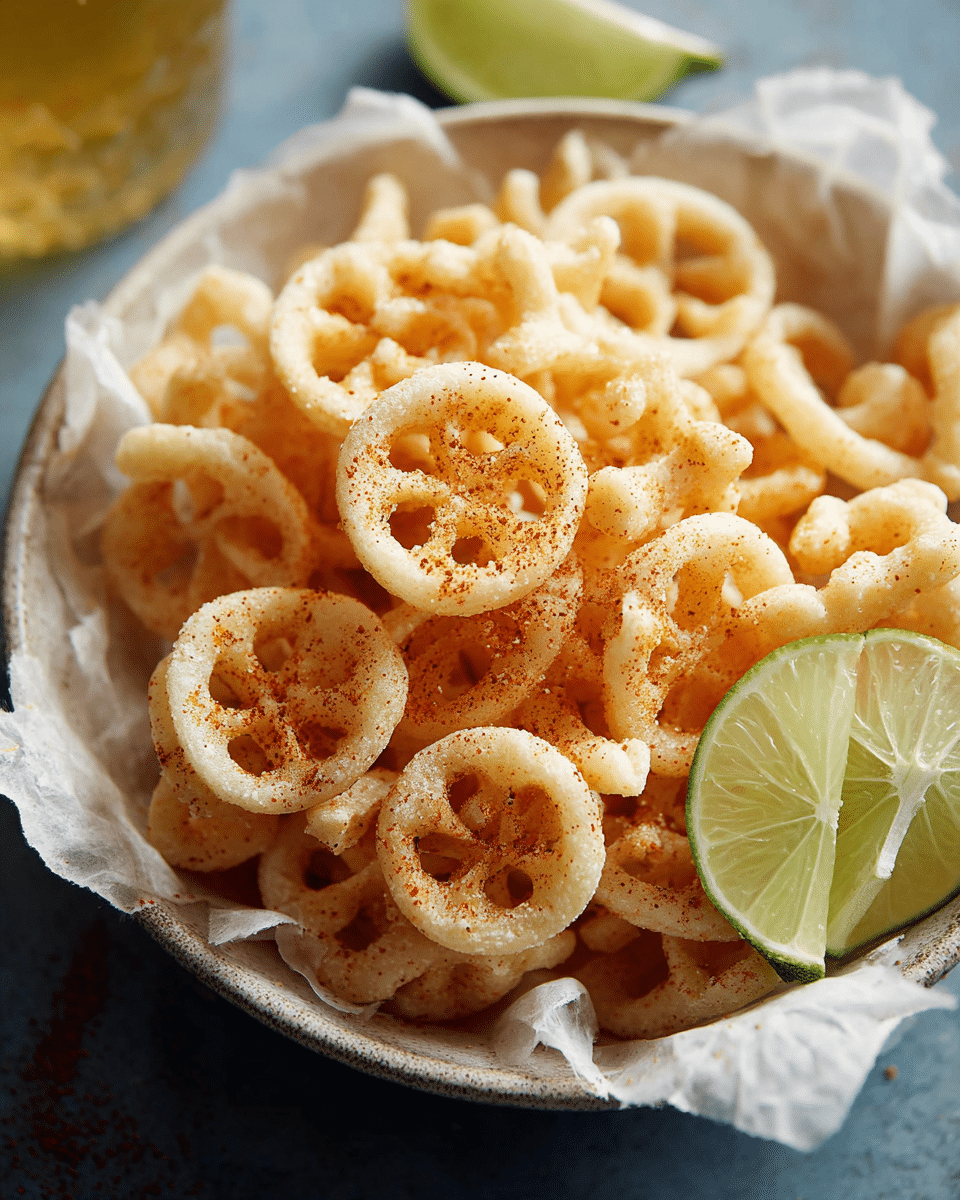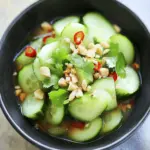The golden puff of each crispy wheat wheel is a nostalgic nod to every childhood trip past a street vendor’s cart in Mexico. Chicharrones de Harina, also known as duros or Mexican pinwheel chips, are light, airy, and full of tangy, spicy flavor when dressed with lime, chili, and a dash of hot sauce.
This homemade version is surprisingly easy and quick requiring just a handful of ingredients and minutes in hot oil. Perfect as a party snack, movie night treat, or to satisfy those street food cravings, these crunchy bites are sure to transport your taste buds straight to a bustling Mexican plaza.
Full Recipe:
Ingredients:
-
2 cups chicharrones de harina (uncooked wheat pasta wheels)
-
3 cups vegetable oil (for frying)
-
Fresh lime wedges
-
1 teaspoon chili powder (or Tajín)
-
Salt to taste
-
Optional: hot sauce (Valentina, Tapatío, or your favorite)
Directions:
-
Heat the vegetable oil in a large, deep pan over medium-high heat (about 350°F / 175°C).
-
Once the oil is hot, add a small batch of the uncooked chicharrones de harina. They will puff up rapidly within 10-15 seconds.
-
As soon as they puff and turn slightly golden, remove them with a slotted spoon and place on a paper towel lined plate to drain excess oil.
-
Repeat with remaining pasta wheels in small batches to avoid overcrowding.
-
While still warm, sprinkle with salt and chili powder (or Tajín), squeeze lime juice on top, and add hot sauce if desired.
-
Serve immediately for the crispiest texture.
Prep Time: 5 minutes | Cooking Time: 10 minutes | Total Time: 15 minutes
Kcal: 150 kcal per serving | Servings: 6 servings
Discovering Chicharrones de Harina: A Crispy Mexican Classic
When you think of iconic Mexican street snacks, images of elotes, tamarind candies, and paletas might come to mind. But one lesser-known gem that packs a serious nostalgic punch is Chicharrones de Harina a light, crispy, and savory snack that’s as fun to eat as it is to say. Often mistaken for pork rinds due to the shared name “chicharrones,” these golden puffs are actually made from wheat flour, not meat, making them a vegetarian-friendly option that’s popular across Mexico.
These wheat based crisps are most commonly shaped like pinwheels, but they also come in other fun shapes like rectangles, squares, or even animals especially when targeted at kids. Deep-fried to perfection, they puff up in seconds and are usually sprinkled with chili powder, drizzled with lime juice, and served with a squirt of hot sauce. The result? A deliciously tangy and spicy bite that satisfies crunchy cravings and evokes warm memories of afternoons spent at street fairs, markets, and after-school snack stands.
A Brief History of Chicharrones de Harina
While the exact origins of chicharrones de harina are hard to trace, their popularity soared in Mexico in the late 20th century when ready-to-fry versions began appearing in neighborhood shops and bulk food markets. They were especially beloved by schoolchildren and became a staple of Mexican snack culture due to their affordability, vibrant flavor, and festive look.
These snacks were often sold by antojito vendors street food sellers who specialized in small, crave worthy bites. The vendor would fry the wheat crisps on the spot using a portable burner or oil drum, then top them with lime juice and chili powder according to the customer’s taste. The process of watching the pasta wheels puff up in oil in mere seconds adds a touch of theatre to an otherwise simple recipe.
Interestingly, the word “chicharrón” traditionally refers to fried pork skin. So the name “chicharrones de harina” (literally “wheat chicharrones”) highlights the snack’s visual and textural similarity to pork rinds crispy, golden, and full of crunch but distinguishes it through its plant-based ingredients.
Flavor Profile and Texture
At its core, chicharrones de harina are all about contrast. They’re crispy but light, spicy yet tangy, and salty but balanced with a hint of lime. The base wheat dough doesn’t carry a strong flavor, which makes it the perfect canvas for bold toppings like:
-
Chili powder or Tajín (for heat and zing)
-
Fresh lime juice (for acidity)
-
Salt (for flavor enhancement)
-
Hot sauce (for a kick of spice)
The magic lies in how these simple ingredients come together. With every bite, you get a burst of texture and taste that makes you reach for just one more wheel. They’re addictively good ask anyone who’s ever grown up with them!
Street Food and Cultural Significance
In Mexico, food is more than sustenance it’s a sensory experience, an expression of heritage, and a celebration of community. Chicharrones de harina are no exception. They represent a deeply nostalgic snack that many Mexicans associate with their childhood, particularly in urban areas.
These snacks are often found at:
-
Street markets (tianguis)
-
School canteens
-
Public parks
-
Fiestas and local festivals
-
County fairs and carnivals
Many kids remember buying a bag for just a few pesos after school, often choosing their favorite shape or asking for extra lime and hot sauce. For adults, the smell and taste of chicharrones de harina can instantly transport them back to carefree afternoons and warm summer evenings.
It’s also a fun, interactive snack. The vendor usually asks how spicy you want them, and it’s not uncommon for people to carry their own hot sauce to get the mix just right. The snack has even become popular at sports games and concerts, where vendors walk the aisles shouting, “¡Chicharrones con chile y limón!”
Versatility and Modern Twists
As the popularity of Mexican snacks has grown internationally, chicharrones de harina have found their way into fusion menus and gourmet snack aisles. While the traditional preparation involves deep frying, some food bloggers and health-conscious cooks are now experimenting with:
-
Air frying: To achieve puffiness without oil saturation.
-
Oven roasting: A lighter alternative that still delivers a good crunch.
-
Different spice blends: Such as smoked paprika, garlic salt, or even truffle-infused chili powder.
-
Sweet versions: A few adventurous creators have tried coating them in cinnamon sugar for a dessert-like twist.
They’re also a favorite canvas for toppings. Think crumbled cotija cheese, chopped cilantro, or even avocado crema. While purists may prefer the classic lime and chili combo, there’s plenty of room to get creative.
Nutritional Notes
Chicharrones de harina are definitely in the indulgent snack category. Because they are deep fried, they can be high in fat and calories. However, they’re also typically consumed in small portions, and when enjoyed occasionally as part of a balanced diet, they can be a guilt-free treat.
One of their advantages is that they’re meat-free, which makes them suitable for vegetarians a distinction from traditional pork chicharrones. You can also control the sodium and spice level when making them at home, allowing for a healthier, personalized snack.
For those with dietary restrictions, it’s worth noting that they do contain gluten, so they are not suitable for those with celiac disease or gluten sensitivity.
Serving Suggestions and Pairings
The best way to enjoy chicharrones de harina? Fresh and hot, right after frying.
Here are a few serving ideas:
-
Party platter: Serve in paper cones with a variety of toppings on the side lime wedges, chili powders, salsas, and crema.
-
With beer: Their spicy, salty nature pairs wonderfully with light beers, micheladas, or even a chilled margarita.
-
As a side snack: Pair with guacamole, mango salsa, or even a ceviche tostada for a crunchy twist.
-
For kids’ parties: Offer the animal-shaped versions with mild seasoning and a yogurt-based dip.
They’re also ideal for Día de los Muertos, Cinco de Mayo, or as a unique addition to your next taco night.
Where to Buy or How to Store
You can find uncooked chicharrones de harina in Mexican grocery stores, Latin markets, or online retailers. They’re usually sold in large bags of dried pasta shapes and can be stored in a cool, dry place for months.
Once cooked, it’s best to eat them the same day, as they can lose their crispiness over time. However, if you have leftovers, store them in an airtight container lined with a paper towel to absorb any residual oil and keep them crunchy.
Conclusion:
Chicharrones de harina are more than just a snack they’re a cherished piece of Mexican culture and childhood. With their irresistible crunch, customizable flavors, and eye-catching shapes, they offer a delightful way to explore authentic Mexican street food from the comfort of your own kitchen.
Whether you’re revisiting this nostalgic treat or discovering it for the first time, making chicharrones de harina at home is a fun and flavorful journey. Add your favorite toppings, invite some friends over, and enjoy a snack that brings people together through simplicity, spice, and a whole lot of crunch.






